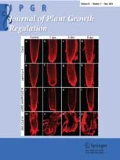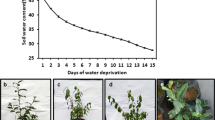Abstract
As the outermost hydrophobic layer, cuticular waxes serve as an essential waterproof barrier to protect plants from desiccation, but the mechanism of wax accumulation still remains unclear. We analyzed the response of cuticular wax composition and deposition to drought in three different watermelon germplasms, namely, M20, M08, and J5F, which showed similar stomatal response, but high, moderate, and low tolerance to drought, respectively. Among the identified 28 compounds of cuticular waxes on leaves, more alkanes with chain lengths of C29 and C31 were induced in M20, accompanied by an increased transcript levels of CER1 (very-long-chain aldehyde decarbonylase 1), when compared to that in M08 and J5F. M20 showed higher total wax amount but fewer platelet-like wax crystals on the upper epidermis of leaves under drought, suggesting the prevalence of more intracuticular waxes embedded into the cutin matrix as fillers. These distinct responses of cuticular waxes in M20 conferred low water loss and high tolerance to drought. Melatonin and abscisic acid (ABA), which can be induced by drought, promoted the biosynthesis of alkanes (C29 and C31) but inhibited the accumulation of wax crystals under drought. Moreover, melatonin inhibited the elevation of ABA levels under mild drought but promoted the ABA accumulation under severe drought, indicating that melatonin and ABA function synergistically to regulate wax compositions to limit non-stomatal water loss under severe but not mild drought in watermelon. These findings can be exploited to improve crop tolerance to drought in arid regions.








Similar content being viewed by others
References
Ahammed GJ, Xu W, Liu A, Chen S (2019) Endogenous melatonin deficiency aggravates high temperature-induced oxidative stress in Solanum lycopersicum L. Environ Exp Bot 161:303–311. https://doi.org/10.1016/j.envexpbot.2018.06.006
Ahammed GJ, Mao Q, Yan Y, Wu M, Wang Y, Ren J, Guo P, Liu A, Chen S (2020a) Role of melatonin in arbuscular mycorrhizal fungi-induced resistance to Fusarium wilt in cucumber. Phytopathology. https://doi.org/10.1094/PHYTO-11-19-0435-R
Ahammed GJ, Wu M, Wang Y, Yan Y, Mao Q, Ren J, Ma R, Liu A, Chen S (2020b) Melatonin alleviates iron stress by improving iron homeostasis, antioxidant defense and secondary metabolism in cucumber. Sci Hortic 265:109205
Arnao MB, Hernández-Ruiz J (2015) Functions of melatonin in plants: a review. J Pineal Res 59:133–150. https://doi.org/10.1111/jpi.12253
Bargel H, Cerman Z, Koch K, Neinhuis C (2006) Structure–function relationships of the plant cuticle and cuticular waxes—a smart material? Funct Plant Biol 33:893–910. https://doi.org/10.1071/FP06139
Barrs H, Weatherley P (1962) A re-examination of the relative turgidity technique for estimating water deficits in leaves. Aust J Bio Sci 15:413–428. https://doi.org/10.1071/bi9620413
Beisson F, Li-Beisson Y, Pollard M (2012) Solving the puzzles of cutin and suberin polymer biosynthesis. Curr Opin Plant Biol 15:329–337. https://doi.org/10.1016/j.pbi.2012.03.003
Bernard A, Joubès J (2013) Arabidopsis cuticular waxes: advances in synthesis, export and regulation. Prog Lipid Res 52:110–129. https://doi.org/10.1016/j.plipres.2012.10.002
Bourdenx B, Bernard A, Domergue F, Pascal S, Léger A, Roby D et al (2011) Overexpression of Arabidopsis CER1 promotes wax VLC-alkane biosynthesis and influences plant response to biotic and abiotic stresses. Plant Physiol 156:29–45. https://doi.org/10.1104/pp.111.172320
Burgess P, Huang BR (2016) Mechanisms of hormone regulation for drought tolerance in plants. In: Hossain MA, Wani SH, Bhattacharjee S, Burritt DJ, Tran LSP (eds) Drought stress tolerance in plants, vol 1 physiology and biochemistry. Springer, Netherlands
Buschhaus C, Jetter R (2012) Composition and physiological function of the wax layers coating Arabidopsis leaves: β-amyrin negatively affects the intracuticular water barrier. Plant Physiol 160:1120–1129. https://doi.org/10.1104/pp.112.198473
Cameron KD (2005) Increased accumulation of cuticular wax and expression of lipid transfer protein in response to periodic drying events in leaves of tree tobacco. Plant Physiol 140:176–183. https://doi.org/10.2307/4282042
Cameron KD, Teece MA, Smart LB (2006) Increased accumulation of cuticular wax and expression of lipid transfer protein in response to periodic drying events in leaves of tree tobacco. Plant Physiol 140:176–183. https://doi.org/10.2307/4282042
Ding F, Wang G, Wang M, Zhang S (2018) Exogenous melatonin improves tolerance to water deficit by promoting cuticle formation in tomato plants. Molecules 23:E1605. https://doi.org/10.3390/molecules23071605
Fu J, Wu Y, Miao Y, Xu Y, Zhao E, Wang J et al (2017) Improved cold tolerance in Elymus nutans by exogenous application of melatonin may involve ABA-dependent and ABA-independent pathways. Sci Rep 7:39865. https://doi.org/10.1038/srep39865
Hasan MK, Ahammed GJ, Sun S, Li M, Yin H, Zhou J (2019) Melatonin inhibits cadmium translocation and enhances plant tolerance by regulating sulfur uptake and assimilation in Solanum lycopersicum L. J Agric Food Chem. https://doi.org/10.1021/acs.jafc.9b02404
Isaacson T, Kosma DK, Matas AJ, Buda GJ, He Y, Yu B, Pravitasari A, Batteas JD, Stark RE, Jenks MA et al (2009) Cutin deficiency in the tomato fruit cuticle consistently affects resistance to microbial infection and biomechanical properties, but not transpirational water loss. Plant J 60:363–377. https://doi.org/10.1111/j.1365-313X.2009.03969.x
Jeffree CE (2008) The fine structure of the plant cuticle. In: Riederer M, Müller C (eds) Biology of the plant cuticle. Blackwell Publishing Ltd., Hoboken, pp 11–125
Jeffree CE, Baker EA, Holloway PJ (1976) Origins of the fine structure of plant epicuticular waxes. In: Dickinson CH, Preece TF (eds) Microbiology of aerial plant surfaces. Academic Press, London, pp 119–158
Jenks MA, Andersen L, Teusink RS, Williams MH (2001) Leaf cuticular waxes of potted rose cultivars as affected by plant development, drought and paclobutrazol treatments. Physiol Plant 112:62–70. https://doi.org/10.1034/j.1399-3054.2001.1120109.x
Jury WA, Vaux H (2005) The role of science in solving the world’s emerging water problems. Proc Natl Acad Sci USA 102:15715–15720. https://doi.org/10.1073/pnas.0506467102
Kerstiens G (1996) Cuticular water permeability and its physiological significance. J Exp Bot 47:1813–1832. https://doi.org/10.1093/jxb/47.12.1813
Kerstiens G (2006) Water transport in plant cuticles: an update. J Exp Bot 57:2493–2499. https://doi.org/10.1093/jxb/erl017
Kim KS, Park SH, Kim DK, Jenks MA (2007) Influence of water deficit on leaf cuticular waxes of soybean (Glycine max [L.] Merr.). Int J Plant Sci 168:307–316. https://doi.org/10.1086/510496
Knoche M, Peschel S, Hinz M, Bukovac MJ (2000) Studies on water transport through the sweet cherry fruit surface: characterizing conductance of the cuticular membrane using pericarp segments. Planta 212:127–135. https://doi.org/10.1007/s004250000404
Koch K, Ensikat HJ (2008) The hydrophobic coatings of plant surfaces: epicuticular wax crystals and their morphologies, crystallinity and molecular self-assembly. Micron 39:759–772. https://doi.org/10.1016/j.micron.2007.11.010
Kong QS, Yuan JX, Gao LY, Zhao S, Jiang W, Huang Y et al (2014) Identification of suitable reference genes for gene expression normalization in qRT-PCR analysis in watermelon. PLoS ONE 9:e90612. https://doi.org/10.1371/journal.pone.0090612
Kosma DK, Bourdenx B, Bernard A, Parsons EP, Lü S, Joubès J, Jenks MA (2009) The impact of water deficiency on leaf cuticle lipids of Arabidopsis. Plant Physiol 151:1918–1929. https://doi.org/10.1104/pp.109.141911
Kunst L, Samuels AL (2009) Plant cuticles shine: advances in wax biosynthesis and export. Curr Opin Plant Biol 12:721–727. https://doi.org/10.1016/j.pbi.2009.09.009
Leide J, Hildebrandt U, Reussing K, Riederer M, Vogg G (2007) The developmental pattern of tomato fruit wax accumulation and its impact on cuticular transpiration barrier properties: effects of a deficiency in a β-ketoacyl-coenzyme A synthase (LeCER6). Plant Physiol 144:1667–1679. https://doi.org/10.1104/pp.107.099481
Li C, Tan DX, Liang D, Chang C, Jia D, Ma F (2015) Melatonin mediates the regulation of aba metabolism, free-radical scavenging, and stomatal behaviour in two malus species under drought stress. J Exp Bot 66:669–680. https://doi.org/10.1093/jxb/eru476
Li H, Mo YL, Cui Q, Yang XZ, Guo YL, Wei CH et al (2019) Transcriptomic and physiological analyses reveal drought adaptation strategies in drought-tolerant and -susceptible watermelon genotypes. Plant Sci 278:32–43. https://doi.org/10.1016/j.plantsci.2018.10.016
Livak KJ, Schmittgen TD (2001) Analysis of relative gene expression data using real-time quantitative PCR and the 2−ΔΔCT method. Methods 25:402–408. https://doi.org/10.1006/meth.2001
Lu SY, Zhao HY, Des Marais DL, Parsons EP, Wen XX, Xu XJ et al (2012) Arabidopsis ECERIFERUM9 involvement in cuticle formation and maintenance of plant water status. Plant Physiol 159:930–944. https://doi.org/10.2307/41549913
Maxwell K, Johnson GN (2000) Chlorophyll fluorescence-a practical guide. J Exp Bot 51:659–668. https://doi.org/10.1093/jexbot/51.345.659
Pachauri RK, Meyer LA, Team CW (2015) IPCC, 2014: Climate Change 2014: Synthesis Report. Contribution of Working Groups I, II and III to the Fifth Assessment Report of the Intergovernmental Panel on Climate Change. J Rom Stud 4:85–88
Panikashvili D, Savaldi-Goldstein S, Mandel T, Yifhar T, Franke RB, Höfer R et al (2007) The Arabidopsis DESPERADO/AtWBC11 transporter is required for cutin and wax secretion. Plant Physiol 145:1345–1360. https://doi.org/10.1104/pp.107.105676
Parsons EP, Popopvsky S, Lohrey GT, Lü S, Alkalai-Tuvia S, Perzelan Y, Paran I, Fallik E, Jenks MA (2012) Fruit cuticle lipid composition and fruit post-harvest water loss in an advanced backcross generation of pepper (Capsicum sp.). Physiol Plant 146:15–25. https://doi.org/10.1111/j.1399-3054.2012.01592.x
Rashidi M, Gholami M (2008) Review of crop water productivity values for tomato, potato, melon, watermelon and cantaloupe in Iran. Int J Agric Biol 10:432–436
Riederer M, Schreiber L (1995) Waxes: the transport barriers of plant cuticles. In: Hamilton RJ (ed) Waxes: chemistry, molecular biology and functions. Oily Press, Dundee, UK, pp 131–156
Samuels L, Kunst L, Jetter R (2008) Sealing plant surfaces: cuticular wax formation by epidermal cells. Annu Rev Plant Biol 59:683–707. https://doi.org/10.1146/annurev.arplant.59.103006.093219
Wang Y, Wang ML, Sun YL, Wang YT, Li TT, Chai GQ et al (2015) FAR5, a fatty acyl-coenzyme A reductase, is involved in primary alcohol biosynthesis of the leaf blade cuticular wax in wheat (Triticum aestivum L.). J Exp Bot 66:1165–1178. https://doi.org/10.1093/jxb/eru457
Xia XJ, Gao CJ, Song LX, Zhou YH, Shi K, Yu JQ (2014) Role of H2O2 dynamics in brassinosteroid-induced stomatal closure and opening in Solanum lycopersicum. Plant Cell Environ 37:2036–2050. https://doi.org/10.1111/pce.12275
Xue D, Zhang X, Lu X, Chen G, Chen ZH (2017) Molecular and evolutionary mechanisms of cuticular wax for plant drought tolerance. Front Plant Sci 8:621. https://doi.org/10.3389/fpls.2017.00621
Yeats TH, Rose JKC (2013) The formation and function of plant cuticles. Plant Physiol 163:5–20. https://doi.org/10.1104/pp.113.222737
Zhang H, Gong G, Guo S, Ren Y, Xu Y, Ling KS (2011) Screening the USDA watermelon germplasm collection for drought tolerance at the seedling stage. HortScience 46:1245–1248
Zhang ZZ, Wang W, Li WL (2013) Genetic interactions underlying the biosynthesis and inhibition of β-diketones in wheat and their impact on glaucousness and cuticle permeability. PLoS ONE 8:1–13. https://doi.org/10.1371/journal.pone.0054129
Zhang HJ, Zhang N, Yang RC, Wang L, Sun QQ, Li DB, Cao YY, Weeda S (2014) Melatonin promotes seed germination under high salinity by regulating antioxidant systems, ABA and GA4 interaction in cucumber (Cucumis sativus L.). J Pineal Res 57:269–279. https://doi.org/10.1111/jpi.12167
Zhou WJ, Leul M (1998) Uniconazole-induced alleviation of freezing injury in relation to changes in hormonal balance, enzyme activities and lipid peroxidation in winter rape. Plant Growth Regul 26:41–47. https://doi.org/10.1023/a:1006004921265
Acknowledgements
This work was supported by the National Key Research and Development Program of China (Grant No. 2018YFD1000800), the National Natural Science Foundation of China (Grant Nos. 31801884, 31972479), the Natural Science Basic Research Plan in Shaanxi Province of China (Grant No. 2018JQ3059), and the Earmarked Fund for Modern Agroindustry Technology Research System of China (Grant No. CARS-25).
Author information
Authors and Affiliations
Corresponding author
Ethics declarations
Conflicts of interest
The authors declare that they have no competing interests.
Additional information
Publisher's Note
Springer Nature remains neutral with regard to jurisdictional claims in published maps and institutional affiliations.
Electronic supplementary material
Below is the link to the electronic supplementary material.
Rights and permissions
About this article
Cite this article
Li, H., Guo, Y., Cui, Q. et al. Alkanes (C29 and C31)-Mediated Intracuticular Wax Accumulation Contributes to Melatonin- and ABA-Induced Drought Tolerance in Watermelon. J Plant Growth Regul 39, 1441–1450 (2020). https://doi.org/10.1007/s00344-020-10099-z
Received:
Accepted:
Published:
Issue Date:
DOI: https://doi.org/10.1007/s00344-020-10099-z




